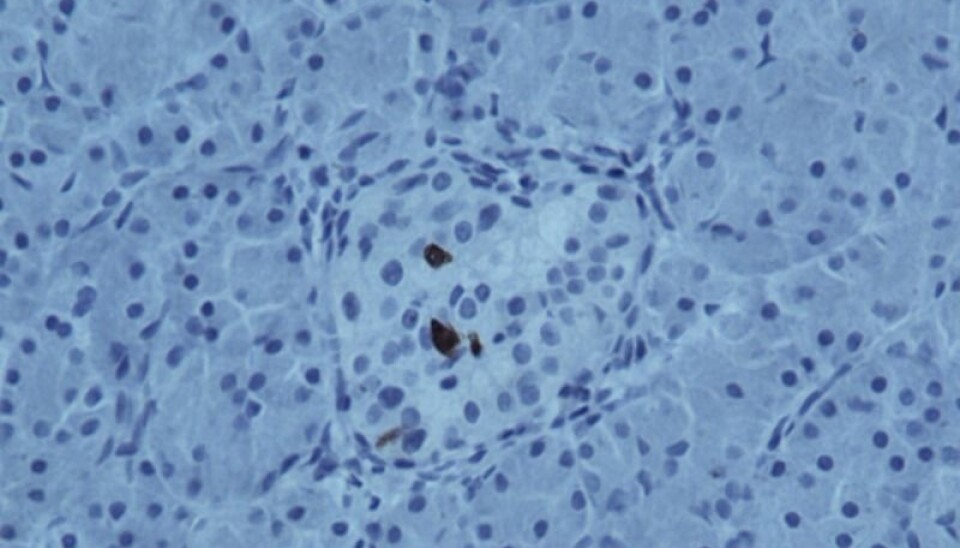THIS ARTICLE/PRESS RELEASE IS PAID FOR AND PRESENTED BY UNIVERSITY OF OSLO - READ MORE

Virus a possible cause of type 1 diabetes
Researchers have found a virus in the pancreas of patients with type 1 diabetes. The discovery may offer the potential for both treatment and a vaccine.
Denne artikkelen er over ti år gammel og kan inneholde utdatert informasjon.
Type 1 diabetes affects children and adolescents. The pancreas stops producing insulin. High blood glucose levels can lead to serious complications such as heart attack, stroke, vision loss, kidney failure and foot amputation.
Daily treatment involving multiple finger-prick blood tests to monitor glucose levels, four to six insulin injections or the use of an insulin pump, all put a great strain on the patient.
Unlike type 2 diabetes, it is not possible to regulate this form of diabetes by exercise or changes in diet. Only 29 percent of patients achieve the recommended treatment goals that prevent complications.
For many years it has been suspected that a virus is a possible cause of type 1 diabetes. A new study has found a virus present in the pancreas of individuals who have recently been diagnosed with this type of diabetes.
The study was headed by Professor Knut Dahl-Jørgensen at the Faculty of Medicine, UiO, in collaboration with Lars Krogvold, research fellow at UiO and consultant paediatrician at Oslo University Hospital.
Common virus in an uncommon place
The researchers identified viral components in the insulin-producing cells in the islets of Langerhans. The islets of Langerhans are hormone-producing groups of cells in the pancreas. The virus that has been detected is in the group of enteroviruses.
Professor Dahl-Jørgensen explains:
“This is a type of virus that occurs frequently among the population. It can cause colds and stomach bugs but also serious infections in the brain and heart, for example”.
Enterovirus is normally found in the intestines and respiratory tract. In individuals with a genetic predisposition the virus has the ability to cause chronic infections.
“It is this type of infection that we have now identified in the insulin-producing cells in the pancreas”, says Dahl-Jørgensen.
Vaccine and treatment
The next step will be to try to develop a vaccine. The work will be done in an EU project in collaboration with two pharmaceutical companies which specialize in developing vaccines. The project will be headed by collaborative partners in Finland.
“Producing new vaccines is a very slow business and extremely expensive. We have to make sure the vaccine is both safe and effective for patients and that adverse effects are minimized,” Lars Krogvold says.
The process usually takes more than five years.
New drugs to treat viral infections are constantly being developed. The hope is to start a project based on patients with newly diagnosed diabetes. If those plans are realized, as early as next year patients could be participating in a clinical trial to test a combination of a new drug and a well-known drug.
“Our hope is that this can stop the destruction of the insulin-producing cells, and preserve the body’s residual insulin production capability. That will lessen the seriousness of the disease. Insulin-producing cells have the ability to regenerate, so if we are very lucky some patients may be able to stop insulin therapy completely", says Krogvold.
New research based on existing theory
An increase in the number of cases of type 1 diabetes was discovered in Norway after a viral epidemic. The number of new cases of type 1 diabetes is highest in the autumn and winter, when we have most virus infections.
Some years ago, researchers found a virus in the pancreas of a child who died of diabetes. Since then, signs of the virus have been identified in the blood of diabetes patients with greater frequency than in healthy individuals.
Earlier lack of evidence
“A virus consists of genetic material surrounded by a protein shell or capsid. We have detected specific proteins from the capsid by immunostaining tissue samples using special antibodies aimed at these proteins. Most importantly, we have also found the genetic material RNA, which is exclusively specific for this type of virus. In addition, changes have been found in genes that are involved in fighting viruses”, says Krogvold.
“Hitherto there were only indirect indications that a virus could trigger type 1 diabetes. We had no evidence to show that the virus is actually in the insulin-producing cells. To be able to say with certainty that diabetes is caused by a virus, the virus must be identified in the morbid cells, which is what we have done. We also have to show that antiviral treatment or vaccines help to remove it,” he says.
“If this is possible, we may be able to stop the process at an early stage and prevent the disease having such a serious progression, or preferably prevent it from arising in the first place”, says Dahl-Jørgensen in conclusion.
Reference:






























